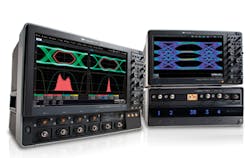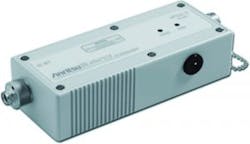Laser, scope, and calibration instruments debut at OFC
OFC marked its 40th anniversary when it convened recently in Los Angeles. The event, which show organizers describe as “the largest global conference and exposition for optical communications and networking professionals,” attracted 12,375 registered attendees and 560 exhibitors occupying 106,000 square feet of exhibit space.
“We couldn’t be happier to cosponsor a conference of this quality and this impact,” said Optical Society CEO Liz Rogan, who also thanked cosponsors IEEE Communications Society and IEEE Photonics Society, which is celebrating its 50th anniversary.1
EE-Evaluation Engineering was unable to attend the event, but we did track down test-equipment vendors to see what products and technologies they introduced at the show.
Tunable laser source
Keysight Technologies highlighted its 81606A tunable laser source, a new module for the 8164B lightwave measurement system (Figure 1). Tunable lasers, in combination with optical power meters and a polarization controller, can measure the filter slope, isolation, polarization dependence, insertion loss, and reflectivity of multiplexers/demultiplexers, channel interleavers, and wavelength-selective switches used in reconfigurable optical-fiber networks.
Courtesy of Keysight Technologies
According to Stefan Loeffler, strategic product planner for the Keysight Digital and Photonic Test Division, speaking in a phone interview before OFC, the new product offers subpico-meter tuning repeatability and best-in-class wavelength accuracy to help validate more devices per hour and speed up automated adjustment of wavelength-selective devices. The company’s N7700A software suite activates the laser and power meters within a measurement system for single-sweep polarization testing. In addition, Loeffler said, “Superior tuning repeatability and linearity reduce the uncertainty of all wavelength-dependent tests”—thereby reducing guardbands and increasing manufacturing yield.
Loeffler said the company’s tunable laser expertise goes back to the step-tunable HP 8161A in 1992. In fact, he said, “Since the HP 8153A lightwave multimeter, our first two-slot mainframe introduced in 1990, we have furnished component manufacturers, researchers, and developers working in photonics and fiber optics with an ever-growing modular test-equipment portfolio, complemented by signal generation and analysis test gear for the terabit era.”
Compared with the current 81600B laser, which Loeffler called the industry standard for more than a decade, the 81606A tunable laser offers these features:
- 15 dB more dynamic range through higher signal power with lower spontaneous emission, enabled by the new cavity and laser module design;
- fourfold improvement in absolute accuracy with increased real-time tracking speed and resolution, enabled by the novel wavelength reference unit; and
- 40 times faster sweeps without impacting the specified dynamic accuracy, enabled by enhanced feedback controls and drive mechanics.
“When component developers validate their designs, they want to get maximum confidence from their measurements in virtually no time,” said Dr. Joachim Peerlings, marketing manager of Keysight’s Digital and Photonic Test Division, in a press release. “We designed the 81606A tunable laser source with that goal in mind. An innovative, autonomous wavelength reference unit and a new cavity design push current benchmarks for measurement accuracy, dynamic range, and test time while ensuring the highest long-term stability and enabling cost-efficient servicing.”
Oscilloscope enhancements
Teledyne LeCroy chose the OFC to announce enhancements to the two highest performance oscilloscope product lines in the company’s portfolio (Figure 2). The new 10 Zi-A delivers improved performance in effective number of bits and baseline noise. The WaveMaster 8 Zi-B features increased sample rate, lower noise, enhanced processing capabilities, and the latest version of Teledyne LeCroy’s advanced oscilloscope user interface, MAUI.
Courtesy of Teledyne LeCroy
The 10 Zi-A builds on the 10 Zi oscilloscope series. The new models include improvements in signal fidelity and noise performance while maintaining performance with respect to bandwidth (100 GHz), sample rate (240 GS/s), and intrinsic (sample clock) jitter (50 fs).
The 10 Zi-A’s modular ChannelSync architecture lets users build oscilloscopes with up to 80 channels with better than 130-fs channel-to-channel jitter. Serial data and optical modulation measurement toolkits, including SDAIII-CompleteLinQ and Optical-LinQ, provide a set of tools for advanced analysis. A new PAM-4 package supports real-time oscilloscope analysis of systems using PAM-4 signaling. These capabilities coupled with the performance enhancements make the 10 Zi-A suitable for engineers designing next-generation high-speed electrical and optical links.
The updated WaveMaster 8 Zi-B enhances the capabilities of its predecessor with lower noise, higher sampling rates, deeper acquisition memory, and the next-generation of Teledyne
LeCroy’s MAUI oscilloscope user interface. SDA 8 Zi-B Serial Data Analyzer models are specifically configured for testing today’s high-speed electronics systems, with an advanced eye and jitter analysis toolkit, additional acquisition memory, and a true hardware serial data trigger. When coupled with Teledyne
LeCroy’s standard-specific analysis options, the SDA 8Zi-B is suitable for testing, characterizing, and debugging USB 3.1, PCI Express, DDR memory, MIPI M-PHY and D-PHY, and other applications.
The U.S. list prices for the 10 Zi-A system start at $215,885. 10 Zi-A systems include either an MCM-Zi-A or SDA MCM-Zi-A along with at least one acquisition module and are available with bandwidths ranging from 20 GHz to 100 GHz. Delivery time is approximately six to eight weeks ARO. WaveMaster 8 Zi-B and SDA 8 Zi-B oscilloscopes are available with bandwidths ranging from 4 GHz to 30 GHz. WaveMaster 8 Zi-B US list prices start at $75,600; SDA 8 Zi-B U.S. list prices begin at $90,600. Delivery time is approximately six to eight weeks ARO.
Courtesy of Anritsu
O/E calibration module for VNAs
Anritsu introduced the MN4765B O/E Calibration Module (Figure 3) for its MS4640B Series VectorStar vector network analyzers (VNAs), creating a cost-effective and flexible solution for measuring 40-Gb/s components and transceivers. Serving as an optical receiver, the MN4765B allows engineers to use the MS4640B Series to perform accurate and stable optoelectronic measurements on laser modulators and photo-receivers during R&D and manufacturing. The MN4765B also can be used with the VNA to characterize optical transmitters, receivers, and transceivers.
Magnitude and phase characterization is obtained using a primary standard characterized by NIST and conducted in the Anritsu calibration lab. The result is improved measurement uncertainty when the MN4765B is used with VectorStar across the VNA’s 70-kHz to 70-GHz frequency range. The MS4640B Series VectorStar VNAs, when calibrated using the MN4765B module, enable error-corrected transfer function, group delay, and return-loss measurements of E/O and O/E components and subsystems.
The MN4765B module is thermally stabilized to eliminate drift in photodiode performance over temperature and designed with additional circuitry for temperature and bias stability. The InGaAs photodiode has a bandwidth response to 70 GHz and a typical responsivity of 0.7 A/W.
The MN4765B module complements the overall performance of the MS4640B VectorStar VNA, which offers the 70-kHz to 70-GHz coverage and can extend coverage to 145 GHz in a broadband configuration. The MS4640B VNA also has a dynamic range of up to 142 dB.
Anritsu also showcased technologies and test solutions for engineers who are designing emerging high-speed transmission products and systems utilizing technologies from 400 Gb/s to 1 Tb/s for applications in the lab, the production floor, and the field.
For R&D applications, Anritsu highlighted its MP1800A BERT signal quality analyzer and MP1825B 4Tap Emphasis. The test solutions will be configured as an ultra-high-speed transmission test system operating up to 1 Tb/s with multichannel synchronization signals, such as Quad DP-16QAM and Dual DP-64QAM. Anritsu also featured a 400+G Super Channel test solution that will combine the company’s MZ1834A 4PAM Converter with the MP1800A to generate 4PAM signals.
For 400-Gb/s Ethernet and 100-Gb/s design and manufacturing environments, Anritsu presented the Network Master Flex MT1100A. This portable transport tester supports simultaneous installation of four independent 100 Gb/s ports, and it can send and receive a variety of 100 Gb/s × 4 client signals to test 400 Gb/s network and transport equipment for Optical Transport Network (OTN) applications.
For field optical test, Anritsu presented the MT1000A Network Master Pro, which supports OTN, MPLS-TP, and Ethernet as well as Fibre Channel, SDH/SONET, and PDH/DSn.
50-GHz electro-absorption modulator
In other news at OFC, nanoelectronics research center imec, its associated lab at Ghent University (Intec), and Stanford University demonstrated a compact germanium (Ge) waveguide electro-absorption modulator (EAM) with a modulation bandwidth beyond 50 GHz. Combining state-of-the-art extinction ratio and low insertion loss with an ultra-low capacitance of just 10 fF, the demonstrated EAM marks an important milestone for the realization of next-generation silicon integrated optical interconnects at 50 Gb/s and beyond.
Future chip-level optical interconnects require integrated optical modulators with stringent requirements for modulation efficiency and bandwidth as well as for footprint and thermal robustness. In the presented work, imec and its partners have improved the state-of-the-art for Ge EAMs on Si, realizing higher modulation speed, higher modulation efficiency, and lower capacitance. This performance was obtained by fully leveraging the strong confinement of the optical and electrical fields in the Ge waveguides as enabled in imec’s 200-mm Silicon Photonics platform. The EAM was implemented along with various Si waveguide devices, highly efficient grating couplers, various active Si devices, and high-speed Ge photodetectors, paving the way to industrial adoption of optical transceivers based on this device.
“This achievement is a milestone for realizing silicon optical transceivers for datacom applications at 50 Gb/s and beyond,” stated Joris Van Campenhout, program director at imec, in a press release. “We have developed a modulator that addresses the bandwidth and density requirements for future chip-level optical interconnects,” he said.
Companies can benefit from imec’s Silicon Photonics platform (iSiPP25G) through established standard cells or by exploring the functionality of their own designs in Multi-Project Wafer runs. The iSiPP25G technology is available via ICLink services and MOSIS, a provider of low-cost prototyping and small-volume production services for custom ICs.
Reference
1. “Upbeat Mood at OFC Signals Market Potential,” OFC Blog, March 26, 2015.
For More Info




